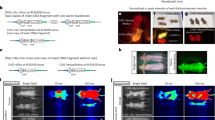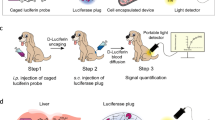Abstract
We generated a sequential reporter-enzyme luminescence (SRL) technology for in vivo detection of β-galactosidase (β-gal) activity. The substrate, a caged D-luciferin–galactoside conjugate, must first be cleaved by β-gal before it can be catalyzed by firefly luciferase (FLuc) to generate light. As a result, luminescence is dependent on β-gal activity. Using this technology, constitutive β-gal activity in engineered cells and inducible tissue-specific β-gal expression in transgenic mice can now be visualized noninvasively over time. A substantial advantage of β-gal as a bioluminescent probe is that the enzyme retains full activity outside of cells, unlike FLuc, which requires intracellular cofactors. As a result, antibodies conjugated to the recombinant β-gal enzyme can be used to detect endogenous cells and extracellular antigens in vivo. Thus, coupling the properties of FLuc to the advantages of β-gal permits bioluminescent imaging applications that previously were not possible.
This is a preview of subscription content, access via your institution
Access options
Subscribe to this journal
Receive 12 print issues and online access
$259.00 per year
only $21.58 per issue
Buy this article
- Purchase on Springer Link
- Instant access to full article PDF
Prices may be subject to local taxes which are calculated during checkout





Similar content being viewed by others
References
Zhang, W. et al. Rapid in vivo functional analysis of transgenes in mice using whole body imaging of luciferase expression. Transgenic Res. 10, 423–434 (2001).
Contag, C.H. et al. Photonic detection of bacterial pathogens in living hosts. Mol. Microbiol. 18, 593–603 (1995).
Contag, P.R., Olomu, I.N., Stevenson, D.K. & Contag, C.H. Bioluminescent indicators in living mammals. Nat. Med. 4, 245–247 (1998).
Edinger, M. et al. Noninvasive assessment of tumor cell proliferation in animal models. Neoplasia 1, 303–310 (1999).
Wu, J.C. et al. Molecular imaging of the kinetics of vascular endothelial growth factor gene expression in ischemic myocardium. Circulation 110, 685–691 (2004).
Gross, S. & Piwnica-Worms, D. Real-time imaging of ligand-induced IKK activation in intact cells and in living mice. Nat. Methods 2, 607–614 (2005).
Choy, G. et al. Comparison of noninvasive fluorescent and bioluminescent small animal optical imaging. Biotechniques 35, 1022–1030 (2003).
Troy, T., Jekic-McMullen, D., Sambucetti, L. & Rice, B. Quantitative comparison of the sensitivity of detection of fluorescent and bioluminescent reporters in animal models. Mol. Imaging 3, 9–23 (2004).
Tang, Y. et al. In vivo tracking of neural progenitor cell migration to glioblastomas. Hum. Gene Ther. 14, 1247–1254 (2003).
Sweeney, T.J. et al. Visualizing the kinetics of tumor-cell clearance in living animals. Proc. Natl. Acad. Sci. USA 96, 12044–12049 (1999).
Lin, A.H. et al. Global analysis of Smad2/3-dependent TGF-beta signaling in living mice reveals prominent tissue-specific responses to injury. J. Immunol. 175, 547–554 (2005).
Welsh, D.K., Yoo, S.H., Liu, A.C., Takahashi, J.S. & Kay, S.A. Bioluminescence imaging of individual fibroblasts reveals persistent, independently phased circadian rhythms of clock gene expression. Curr. Biol. 14, 2289–2295 (2004).
Luker, K.E., Hutchens, M., Schultz, T., Pekosz, A. & Luker, G.D. Bioluminescence imaging of vaccinia virus: Effects of interferon on viral replication and spread. Virology (2005).
Ciana, P. et al. Engineering of a mouse for the in vivo profiling of estrogen receptor activity. Mol. Endocrinol. 15, 1104–1113 (2001).
Contag, C.H. & Bachmann, M.H. Advances in in vivo bioluminescence imaging of gene expression. Annu. Rev. Biomed. Eng. 4, 235–260 (2002).
Ke, S. et al. Near-infrared optical imaging of epidermal growth factor receptor in breast cancer xenografts. Cancer Res. 63, 7870–7875 (2003).
Olafsen, T. et al. Optimizing radiolabeled engineered anti-p185HER2 antibody fragments for in vivo imaging. Cancer Res. 65, 5907–5916 (2005).
Rubin, R.H., Baltimore, D., Chen, B.K., Wilkinson, R.A. & Fischman, A.J. In vivo tissue distribution of CD4 lymphocytes in mice determined by radioimmunoscintigraphy with an 111In-labeled anti-CD4 monoclonal antibody. Proc. Natl. Acad. Sci. USA 93, 7460–7463 (1996).
Miska, W. & Geiger, R. Synthesis and characterization of luciferin derivatives for use in bioluminescence enhanced enzyme immunoassays. New ultrasensitive detection systems for enzyme immunoassays, I. J. Clin. Chem. Clin. Biochem. 25, 23–30 (1987).
Geiger, R., Schneider, E., Wallenfels, K. & Miska, W. A new ultrasensitive bioluminogenic enzyme substrate for beta-galactosidase. Biol. Chem. Hoppe Seyler 373, 1187–1191 (1992).
Miska, W. & Geiger, R. A new type of ultrasensitive bioluminogenic enzyme substrates. I. Enzyme substrates with D-luciferin as leaving group. Biol. Chem. Hoppe Seyler 369, 407–411 (1988).
Masuda-Nishimura, I., Fukuda, S., Sano, A., Kasai, K. & Tatsumi, H. Development of a rapid positive/absent test for coliforms using sensitive bioluminescence assay. Lett. Appl. Microbiol. 30, 130–135 (2000).
Yang, X., Janatova, J. & Andrade, J.D. Homogeneous enzyme immunoassay modified for application to luminescence-based biosensors. Anal. Biochem. 336, 102–107 (2005).
Tung, C.H. et al. In vivo imaging of beta-galactosidase activity using far red fluorescent switch. Cancer Res. 64, 1579–1583 (2004).
Cui, C., Wani, M.A., Wight, D., Kopchick, J. & Stambrook, P.J. Reporter genes in transgenic mice. Transgenic Res. 3, 182–194 (1994).
Jeong, J. & McMahon, A.P. Growth and pattern of the mammalian neural tube are governed by partially overlapping feedback activities of the hedgehog antagonists patched 1 and Hhip1. Development 132, 143–154 (2005).
Candido, E.P. & Jones, D. Transgenic Caenorhabditis elegans strains as biosensors. Trends Biotechnol. 14, 125–129 (1996).
Tajbakhsh, S. et al. Gene targeting the myf-5 locus with nlacZ reveals expression of this myogenic factor in mature skeletal muscle fibres as well as early embryonic muscle. Dev. Dyn. 206, 291–300 (1996).
Cao, Y.A. et al. Shifting foci of hematopoiesis during reconstitution from single stem cells. Proc. Natl. Acad. Sci. USA 101, 221–226 (2004).
Cooper, R.N. et al. In vivo satellite cell activation via Myf5 and MyoD in regenerating mouse skeletal muscle. J. Cell Sci. 112, 2895–2901 (1999).
Mendler, L., Zador, E., Dux, L. & Wuytack, F. mRNA levels of myogenic regulatory factors in rat slow and fast muscles regenerating from notexin-induced necrosis. Neuromuscul. Disord. 8, 533–541 (1998).
Shah, K., Tung, C.H., Breakefield, X.O. & Weissleder, R. In vivo imaging of S-TRAIL-mediated tumor regression and apoptosis. Mol. Ther. 11, 926–931 (2005).
Cao, Y.A. et al. Molecular imaging using labeled donor tissues reveals patterns of engraftment, rejection, and survival in transplantation. Transplantation 80, 134–139 (2005).
Palermo, A.T., Labarge, M.A., Doyonnas, R., Pomerantz, J. & Blau, H.M. Bone marrow contribution to skeletal muscle: a physiological response to stress. Dev. Biol. 279, 336–344 (2005).
Acknowledgements
We would like to thank M. Hammer and M.J. Merchant for technical assistance. The work was funded by a grant of the Deutsche Forschungsgemeinschaft (DE740-1/1) to G.v.D. and grants from the US National Institutes of Health (AG09521, AG20961, HL65572, HD18179) and the Baxter Foundation to H.M.B.
Author information
Authors and Affiliations
Corresponding author
Ethics declarations
Competing interests
H.M.B. is a major stockholder in a company that might have a gain or loss financially through publication of this manuscript.
H.M.B., T.S.W. and G.vD. are inventors of the SRL technology; a patent is pending.
Supplementary information
Supplementary Fig. 1
Lugal and luciferin show biodistribution to major organs following intraperitoneal injection in 2 separate mice. (PDF 232 kb)
Supplementary Fig. 2
Comparison of bioluminescent and fluorescent imaging of β-gal activity. (PDF 45 kb)
Supplementary Fig. 3
Luminescent imaging of β-gal labeled antibodies. (PDF 50 kb)
Supplementary Fig. 4
Colocalization of injected anti-CD4 antibody with TCR-β chain. (PDF 49 kb)
Rights and permissions
About this article
Cite this article
Wehrman, T., von Degenfeld, G., Krutzik, P. et al. Luminescent imaging of β-galactosidase activity in living subjects using sequential reporter-enzyme luminescence. Nat Methods 3, 295–301 (2006). https://doi.org/10.1038/nmeth868
Received:
Accepted:
Published:
Issue Date:
DOI: https://doi.org/10.1038/nmeth868
This article is cited by
-
Portable bioluminescent platform for in vivo monitoring of biological processes in non-transgenic animals
Nature Communications (2021)
-
Chromo-fluorogenic probes for β-galactosidase detection
Analytical and Bioanalytical Chemistry (2021)
-
Cell-specific image-guided transcriptomics identifies complex injuries caused by ischemic acute kidney injury in mice
Communications Biology (2019)
-
Real-time imaging of senescence in tumors with DNA damage
Scientific Reports (2019)
-
Establishment of a novel triple-transgenic mouse: conditionally and liver-specifically expressing hepatitis C virus NS3/4A protease
Molecular Biology Reports (2014)



